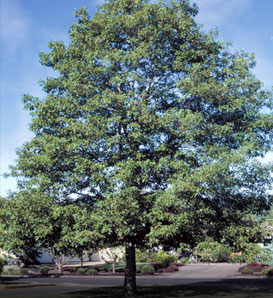Oak, WhiteQuercus alba

An impressive tree with a stately, broad-rounded form. Suitable for larger areas. Dark green leaves in the summer, turn showy red in the fall. Slow to moderate growth rate. Prefers acidic, moist, well-drained soil and full sun. Grows 50'-80', with an equal spread. (zones 3-9).
Try this tree in your yard:

Zones 3 - 9
Hardiness Zones: Zones 3 - 9
The White Oak can be expected to grow in the zones shown in color

Shade Tree
Type of tree:
The White Oak falls into the following type(s): Shade Trees

50' - 80' High
Mature Height:
The White Oak grows to be 50' - 80' feet in height.

50' - 80' Spread
Mature Spread:
The White Oak has a spread of about 50' - 80' at full maturity.

Slow to Medium Growth
Growth Rate:
This tree grows at a slow to medium growth rate.

Full Sun
Sun:
This oak does well in full sun, partial shade.

Various Soils
Soil:
The white oak prefers slightly acid to neutral, deep, moist, well drained soils. While it is adaptable to other soil textures, it is intolerant of alkaline, shallow, or abused urban soils. White oaks are extremely sensitive to compaction and grade changes

Oval Shape
Shape:
This oak has oval, rounded shape.
Attributes:
A majestic tree all year long. In the spring, the new leaves and flowers combine for a pastel tint on the limbs. In the summer, it is a superior shade tree. In the fall, the leaves are rich with color, and the acorns attract an array of wildlife. In the winter, it presents a stately silhouette with light gray platey bark and a wide open crown.The white oak is a tree for large spaces, parks and other recreational areas, golf courses, campuses, cemeteries and other pastoral landscapes. The white oak can live for centuries becoming more picturesque with age.
Description:
The white oak is a large, strong, imposing specimen. It has a short stocky trunk with massive horizontial limbs.The wide spreading branches form an upright, broad-rounded crown. The bark is light ashy gray, scaly or shallow furrowed, variable in appearance, often broken into small, narrow, rectangular blocks and scales.The leaves are dark green to slightly blue-green in summer, brown and wine-red to orange-red in the fall. The fall foliage is showy. Oaks are wind pollinated. Acorns are produced generally when the trees are between 50-100 years old. Open-grown trees may produce acorns are early as 20 years. Good acorn crops are irregular and occur only every 4-10 years. The white oak prefers full sun, but has a moderate tolerance to partial shade. It is more shade tolerant in youth, and less tolerant as the tree grows larger. It can adapt to a variety of soil textures, but prefers deep, moist, well-drained sites. High pH soil will cause chlorosis. Older trees are very sensitive to construction disturbances. The deep tap root can make transplanting difficult. Transplant when young. New transplants should receive plenty of water and mulch beneath the canopy to eliminate grass competition. Old oaks on upland sites can be troubled by sudden competition from and excessive irrigation of newly planted lawns. Their root zones must be respected for them to remain healthy. White oak is less susceptible to oak wilt than the red oak species.
Wildlife Value:
The acorns are one of the best sources of food for wildlife and are gathered, hoarded, and eaten by birds, hoofed browsers, and rodents. Leaf buds also are eaten by several bird species and all parts of the tree are a favorite deer food.
History/Lore/Use:
A native north American tree with a natural range that extends from southern Quebec, the edge of Ontario, central Minnesota across to Maine, south to east central Texas to southern Georgia and Florida.This is the most important species of the white oak group. It is the state tree of Connecticut, Illinois, and Maryland. Graphic artists use the classic rounded outline of the leaf to symbolize the genus. The logo of the Nature Conservancy consists simply of the silhouette of a white oak leaf. There are a few varient forms of white oak. but no commercial cultivars available yet. White oaks can be hybridized with other oaks, and there are several superior selections of hybrids in the nursery trade. The wood is used for flooring, furniture, interior finishing, cabinetmaking, shipbuilding, wine and whiskey casks.
Moisture:
The white oak grows best in moist, well drained soil. It tolerates moderate drought and occasionally wet soil.
Leaves:
The leaves are alternate, simple, obovate to oblong-obovate, 4-8 1/2" long. red to pink to gray in spring, dark green to slightly blue-green in summer, brown to deep red to burgundy in the fall. Brown interior leaves may persist into early winter.
Flower Color:
Female pistallate flowers are reddish, minute, single or paired on short stalks, male staminate flowers are yellow green in drooping clustered catkins, not showy in the spring.
Fruit Description:
Solitary or paired, tan brown, 3/4"-1" nut enclosed in a light brown, bowl-like cap (involucre). The involucre has raised warty scales. The acorns ripen the first year falling in September to October